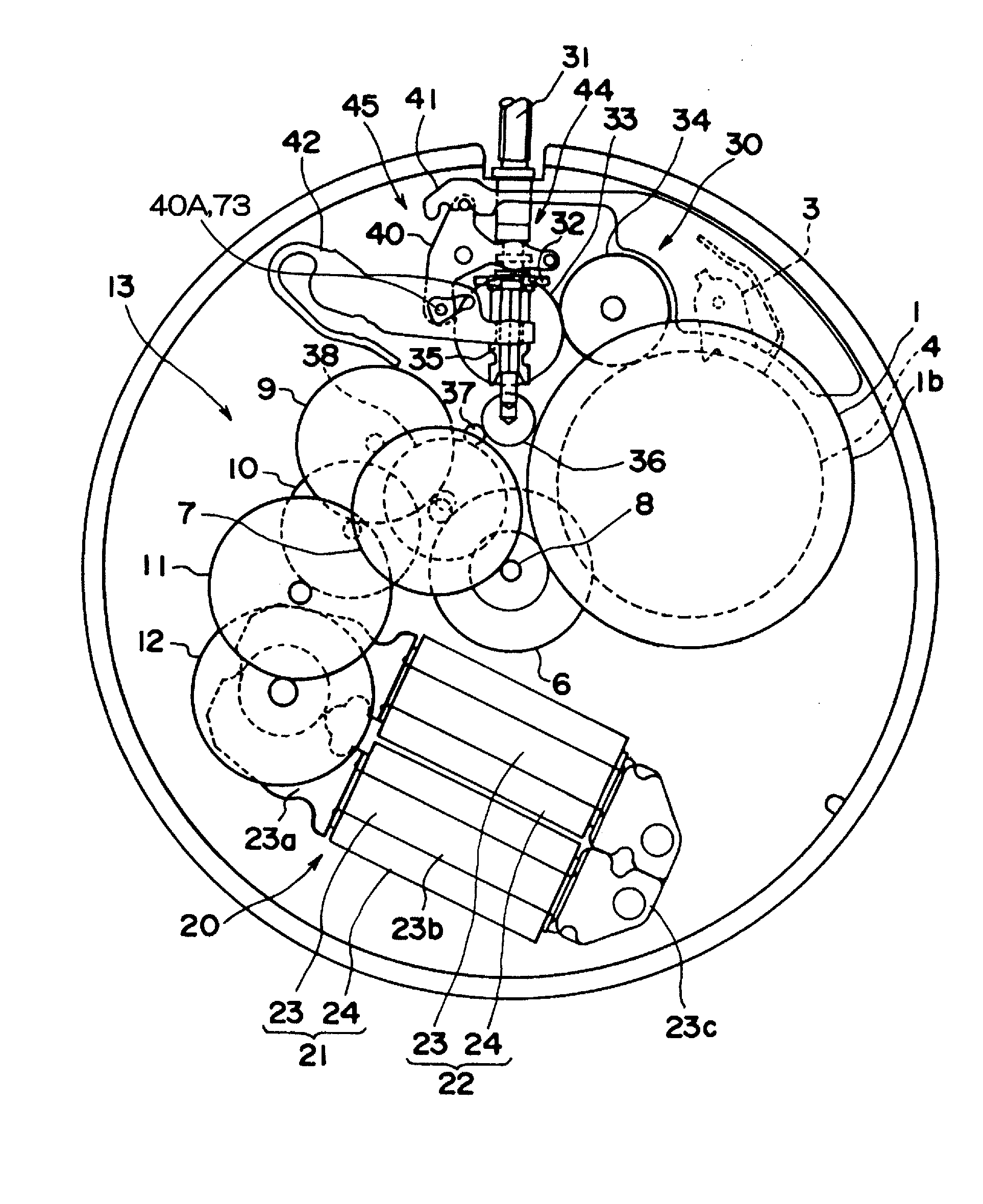Timepiece component and timepiece having the timepiece component
a timepiece and component technology, applied in instruments, horology, gearworks, etc., can solve the problems of increasing the coefficient of friction to approximately 0, rough plating at the contact surface, increasing the coefficient of friction, etc., to improve the oil retention of sliding friction parts, improve wear resistance and lubricity, and facilitate long-term use of timepieces.
- Summary
- Abstract
- Description
- Claims
- Application Information
AI Technical Summary
Benefits of technology
Problems solved by technology
Method used
Image
Examples
embodiment 1
[0056]General Arrangement of an Electronically-Controlled Mechanical Timepiece
[0057]A first embodiment of the invention is described below with reference to the accompanying figures.
[0058]FIG. 1 is a schematic plan view of an electronically-controlled mechanical timepiece according to this embodiment of the invention, and FIG. 2 and FIG. 3 are section views showing a main part of FIG. 1.
[0059]As shown in FIG. 1 to FIG. 3, the electronically-controlled mechanical timepiece has a mainspring 1a, a barrel wheel 1b, a barrel arbor 1c, and a barrel cover 1d. The outside end of the mainspring 1a is fixed to the barrel wheel 1b and the inside end is fixed to the barrel arbor 1c. The barrel arbor 1c is supported on the main plate 2, and rotates in unison with the ratchet wheel 4.
[0060]The ratchet wheel 4 rotates clockwise and engages a detent 3 so that the ratchet wheel 4 does not rotate counterclockwise. The ratchet wheel 4 is arranged so that when a winding stem 31 connected to a crown not...
embodiment 2
[0098]A second embodiment of the invention is described next. As shown in FIG. 8 this embodiment of the invention lubricates between the third pinion 71 and bottom pivot 72 and the pivot hole 51 with a special horological oil 76. Except for this use of lubrication, the arrangement of a timepiece according to this embodiment of the invention is the same as the timepiece according to the first embodiment.
[0099]FIG. 9 is an enlarged view of the surface of the third pinion 71 and bottom pivot 72 coated with a composite plating 73.
[0100]As shown in FIG. 9 the horological oil 76 is held by the carbon nanotubes 75A in the carbon nanotube layer 75. Because the carbon nanotube layer 75 is unoriented, the oil is impeded from flowing in any direction and the oil is retained uniformly.
[0101]As in the first embodiment, the surfaces of the third pinion 71 and the bottom pivot 72, or more specifically the surfaces that contact the pivot hole 51, are coated with a composite plating 73 (FIG. 4) in t...
PUM
| Property | Measurement | Unit |
|---|---|---|
| thickness | aaaaa | aaaaa |
| length | aaaaa | aaaaa |
| surface roughness Ra | aaaaa | aaaaa |
Abstract
Description
Claims
Application Information
 Login to View More
Login to View More - R&D
- Intellectual Property
- Life Sciences
- Materials
- Tech Scout
- Unparalleled Data Quality
- Higher Quality Content
- 60% Fewer Hallucinations
Browse by: Latest US Patents, China's latest patents, Technical Efficacy Thesaurus, Application Domain, Technology Topic, Popular Technical Reports.
© 2025 PatSnap. All rights reserved.Legal|Privacy policy|Modern Slavery Act Transparency Statement|Sitemap|About US| Contact US: help@patsnap.com



